#absolute mammal
Explore tagged Tumblr posts
Text

13 notes
·
View notes
Text
anyway the whole argument of "this animal sucks it is unfit to live and is destined for extinction" was also applied to the thylacine so if you invoke that argument for any extant species you are a fake thylacine fan
#marsupials were classified as lesser mammals by european colonists even in the early 1900s#it was seen as the natural march of progress for placental carnivores to replace native marsupial predators#yes thylacines were dealt a blow before the british arrived but they were absolutely not 'destined for imminent extinction'
777 notes
·
View notes
Photo




Technically speaking, if he isn't... thirsty, hungry, in danger, or pain, then...broadly speaking, I suppose he is happy. What about you?
MAMMALS 1.06
#colin morgan#jeff wilson#mammals#ee#gifs#tvedit#can i be honest. i didn't make it through this series because i genuinely don't care about what was happening to james corden#i watched colin's scenes but i can't tell really what his deal is? he has an absolutely awful time in this episode specifically#he drops acid after this and cries and tries to throw himself off a bridge (?)
526 notes
·
View notes
Text
Hozier heard about morning people and went
Respectfully,
✨️NO✨️
#hozier#unheard hozier#too sweet#hozier too sweet#hozier unheard#he heard about health nuts and went absolutely not thank u i like fun#he heard about puritanism and went sorry i am A Mammal which is An Animal and actually I Love Life
971 notes
·
View notes
Note
I WAS GONNA MESSAGE YOU ON YOUR MAIN BUT IT WOULD MAKE MORE SENSE HERE
I know Luca did this but I love the idea of fish being treated domestic cattle? Like idk something about having a group of fish just. Grazing. Idk

Our grunts were doing this earlier and I thought it was silly like that’s a herd not a school
ANYWAYS in your mermaid verses does like. Aquaculture/agriculture combination exist?
Yes yes yes it does!!! Tending to domestic schools of fish is one of the biggest food sources of merfolk, though I've only really brought it up once in a singular comic panel:

Aand admittedly I haven't figured out all the logistics of it ^^' There are domestic fish subspecies for sure, pikes and several species of sharks for example, but the livestock of the sea are a different matter. I like the idea of fully domestic fish subspecies that live with humans all the time but I also like the domestic reindeer approach where — despite the prefix "domestic" — the reindeer spend a large portion of the year in the wild and only come to humans' care for the winter. I guess it'd be tricky to keep fish in a single place without having any escape (3-dimensional space and all), but also, I feel like domestic fish would be accustomed to merfolk and would wish to school near them anyway due to the protection they offer.
Actually, the domestication of fish seems like a very natural course to take place. Merfolk are big to most fish, medium shark-sized, and do not pose an immediate threat, so they're good to school near. Merfolk change their environment in all sorts of ways, they expose prey to eating when obtaining materials, they build things, and then those things grow tasty algae and polyps and mussels to eat. Merfolk eat a lot themselves and leave cooked food scraps to enjoy. Merfolk don't like predators near them and therefore chase them away, giving the fish safety, and once they start building little barns for the fish, well, then they'll be extra safe!! Perhaps then, merfolk settlements (located near coasts) would keep these fully domestic schools, and more nomadic groups of merfolk (who travel in the uppermost levels of the pelagic zone) would have semi-domestic schools of fish to keep instead.
Huh, yeah, fish livestock must come in very handy in taking care of biofouling matters, snails and slugs and other grazers can't do it all by themselves. Oooh not to mention the possibilities for aquaponics!!!! Domestic fish graze on algae and tasty delicious things to them, their waste fertilises the big plants (and worms) delicious to humans, humans eat both as they grow, profit! Although just how nutrient-heavy the water must be in these aquaculture farms due to the large amount of fish livestock, ehhh.... balancing how close to settlements you can keep the livestock in the name of food delivering efficiency vs how far you need to have them be to keep the water clean, what a tricky matter. Excellent for worldbuilding though :D I bet it's a really pressing issue regarding the eutrophication and species loss of the environment, merfolk settlements being located so far away from their agricultural areas for comfort and cleanliness reasons, inadvertedly causing their spheres of influence to be much bigger, forcing natural ecosystems to grow smaller, more fragmented and more nutrient-heavy, and causing disruption in the ecosystems' natural processes. Nevermind how much food exporting must've caused aquaculture farms to grow massive, especially in the modern age where the demands of billions of people must be met!! See, just because they're in the water doesn't mean they're more rudimentary or more in-tune with nature, lol.
To make a long story short, yeah !!!! Merfolk keep fish, but also other groups of animals like reptiles, crustaceans, mollusks and annelids to eat... and also to have as buddies and do jobs! Not all fish are livestock, very few fish species are "fitting" enough to be domesticated, and even then wild and domestic populations of the same species exist, but some species are livestock and serve as a major cornerstone of the merfolk diet!
#im a little bit tired of the idea that mermaids should be absolutely frightened and disgusted at the idea of eating fish.#i mean... what DO they eat then? algae? whales? small crustaceans? do they absorb the sunlight? lol#they CAN do all those things but like tell me how and why! why do they have the reactions that they do? whats their mermaid culture like?#if theres no reason then to me it just seems like they dont eat fish because some folks consider all fish to be a monolith where no nuance#or difference exists between species besides very clear categories of “fish” and “shark”. and mermaids are of course a part of this monolit#like when people accuse donald duck of cannibalism for eating turkey when donald is an anthropomorphic duck and the turkey he eats is a -#feral bird of a wholly different species#not here! merfolk live with fish and clearly distinguish between different species just like we see the obvious differences between -#squirrels and shrews and moles and rats and lemmings and several other mammals despite all of them being “mammals”#ahti II loves fish but also “fish” is a broad category and includes animals he wouldnt ever eat and animals that he regularly eats and -#finds absolutely delicious#i dont say this to be edgy! i say this because this is what happens in real life#anyway. i love the idea of fish livestock. schools of herring floating above the shallow seafloor grazing away while a shepherd makes sure#they dont wander off from the underwater pasture. the shepherds pikes circle the school and keep it in shape#asks#oh-sturg#sirpaverse#merfolk#mermaid#taur hour
30 notes
·
View notes
Text
oooooohh h.......... she said 'aisle'
#her name is gospel-chan!!#she is ABSOLUTELY PRECIOUS#so talented and wonderful#gospel-chan#seal named gospel#spotted seal#spotted seals#pinnipeds#marine mammals
472 notes
·
View notes
Text
Colin Morgan Thirst Poll
S5 Merlin

S1 Humans

S3 Humans

The Living and the Dead

The Fall

We Hunt Together

Benjamin

Belfast

Mammals

Testament of Youth

The Tempest
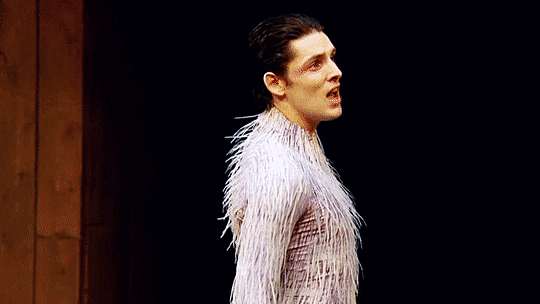
#yes i'm okay!! just answer the question#there's no wrong answer but jsyk I think it should be mammals. benjamin also allowed.#if you haven't seen the fall i want to point out they made him wear eyeliner in some scenes#for absolutely no reason at all. he played a cop.#but they went like... we need him to look se*xy. let's put some makeup on him. something subtle.#like they really thought people wouldn't notice#i just find it funny sorry#anyway. pls answer this.#colin morgan#polls#merlin#(yes leo elster is in here twice. is that a problem.)
232 notes
·
View notes
Text

Enjolras brings out the part of me that wants to fuck older men like the animal I am. Of course it's not just him, Grantaire was basically my introduction to that feeling.
#I mean#we're technically mammals#so-#les mis#enjolras#les amis de l'abc#les amis#les miserables#gonna absolutely destroy that ass
21 notes
·
View notes
Text
god the human spine is such a shitshow. i’d much rather trade back my thumbs and self-recognition for a neutral horizontal spine and pelvis cuz this fucking upright mess is not worth it lmfao worst evolution ever award !
#we really are tho. no protective fur horrible pelvis that kills us in birth terrible spine leverage no third eyelid#absolutely horrendous neck position#once again no armoring at ALL#capacity for and inevitably of neuroses#and psychoses#poor temperature regulation#bones set up for degenerative conditions and lifelong inflammation#babies way too soft and unformed#incredibly fragile gestation#awful eyesight and practically dull senses compared to all other mammals#it goes on
9 notes
·
View notes
Text









#gojo kitty#i lovw this little mammal too much#have you ever kissed a sleeping kitty? absolutely magical#when they sleep on you#all is right in the world#even when he is bejng a menace i love him with all my heart
3 notes
·
View notes
Text
THE LAST TRACE OF STEELJAW IS HIM HOWLING HORRIBLY. WHAT THE FUCK
#THE WAY I CRINGED. IT KILLED ME#oh my godd why would he howl like that#i still love him but love has limits what the fuck was that#sheep watches rid15#ALSO. OFFICIALLY DONE WITH THIS SERIES#amazing how i started rewatching as a joke but then became attached to characters#plus i started watching this in a discord server. but we never finished it. steeljaw kept gnawing at my brain and i had to finish watching#this was something#i cant say i hated rid15?? Surprisingly#some of the cons made it bearable to watch#may i mention#that i absolutely love the beastformers on this show#we got corvids. vampires/bats. A BUNCH OF INSECTS. mammals. sea creatures. whatever the chompazoids are. dinobots. A SNAKE.#i love the variety tbh
6 notes
·
View notes
Text
Action Potentials and Refractory Periods - Diagram

Patreon
#studyblr#notes#medblr#medical notes#med notes#neurology#neurophysiology#neurology notes#physiology#physiology notes#anatomy and physiology#refractory period#absolute refractory period#my notes#physio#physio notes#anatomy & physiology#animal physiology#mammalian physiology#mammal physiology#vet sci#vet science#vetblr#veterinary science#animal science#advanced physiology#comparative physiology#evolutionary physiology#biology#life science
2 notes
·
View notes
Text
I haven't covered any pinniped pals for Wet Beast Wednesday yet, so for my first one I'm going big. Really big. Elephant seal big. Elephant seals are not only the largest of all pinnipeds, they are the largest of all carnivorans and the largest marine mammals that aren't cetaceans. There are two species: northern (Mirounga angustirostris) and southern (Mirounga leonina), with the southern species being the larger of the two.
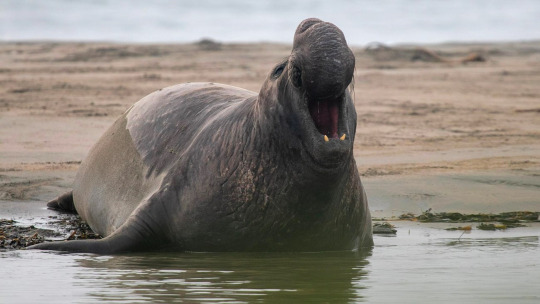
AAAAAAAAAAAAAHHHHHHHHH! (image: an elephant seal bellowing)
Elephant seals are true seals (as opposed to sea lions and walruses), meaning they lack external ears and their hind legs have fused into a sort of pseudo-flipper that allows for highly efficient swimming but is of little use when maneuvering on land. While it is common among pinnipeds for males to be larger than females, elephant seals exaggerated that with one of the most extreme size differences between sexes. Females of both species range from around 350 to 900 kg (880 to 1,980 lbs) and 2.5 to 3.6 m (8.2 to 11.8 ft) in length. Male northern seals average between 1,500 to 2,300 kg (3,300 to 5,100 lbs) and 4-5 m (13-16 ft) while southern males break the scale at 1,500 to 3,700 kg (3,300 to 8,200 lbs) and 4.2 to 5.8 m (14 - 19 ft). The southern species has the largest mass difference between sexes of any mammal, with the males averaging 5-6 times the weight of the females.

(image: male and female elephant seals chillaxing on a beach)
In addition to the size difference, the other major form of sexual dimorphism is that the male has his nose elongated into a proboscis. This snout serves two major functions: it amplifies the roars of the male allowing him to be remarkably loud and it traps and reabsorbs moisture when he exhales. This is important as the seals do not eat or drink when on land and recapturing moisture lets him stay hydrated.
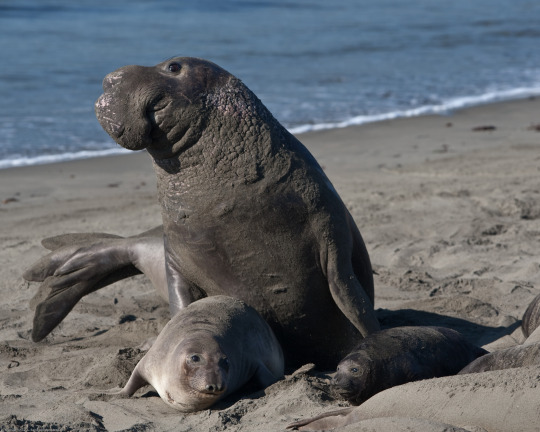
(image: a male[top], female [bottom left] and juvenile [bottom right] northern elephant seal)
Seals are adapted to spend the vast majority of their lives in the water and elephant seals are no different. They spend around 80% of their lives in the water and have many adaptations to aid in their lifestyle. Like most marine mammals, they have a thick layer of fatty blubber that preserves heat in cold water, reduces drag, and provides buoyancy. Like other seals, they can slow their heartbeats and redirect blood flow to the core of their body to avoid losing heat. Another seal adaptation is that veins returning blood to the heart grow near arteries carrying blood from the heart. This allows the cold returning blood to leech some heat from the arteries to avoid cooling down the body's core. They have a lot of blood to store oxygen, allowing for long dives. Elephant seals dive deep (averaging 300-600 m but occasionally much deeper) when searching for food. Females typically go on deeper but shorter dives than males. They can hold their breath for over 100 minutes, longer than nay non-cetacean mammal.. Their eyes are highly adapted to low-light conditions and their whiskers can sense motion in the water, both things that aid in finding food. Elephant seals are very opportunistic predators and will eat a large variety of fish and cephalopods.

(image: a female elephant seal swimming)
The 20% of time not spent at sea is mostly taken up by two yearly periods: the molting and breeding seasons. In both cases, the seal will haul out onto the beach and will not eat or drink until it has finished. Molting season lasts about a month and usually occurs in summer. Elephant seals undergo what are called catastrophic molts, where they not only shed and regrow their fur but their outer layer of skin. During the regrowth of their skin, extra blood has to be directed toward it. In the water, this would cause too much heat loss, so it must be done on land. The skin sheds in large patches and not all at once, resulting in molting seals having a ragged appearance.
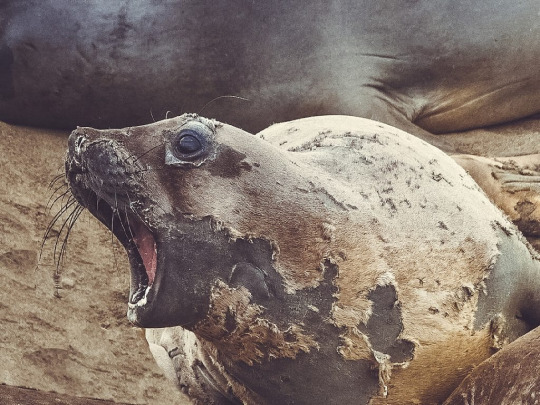
(image: a seal mid-molt)
The longer and more famous time on land is breeding season. In early spring, males will arrive on beaches and fight each other for dominance. In time, a few alpha males will claim most of the beach. These fights last even after the females arrive. Fights are very dramatic, involving posing and bellowing. If one male does not submit, they will fight by biting and slapping each other with their heads. Fights are rarely fatal, but are frequently bloody. Males have thicker skin on their chests to protect them during fights. Alpha males claim the right to mate with the females. Other males are forced to the outskirts of the beach, where they try to mate while the alpha is distracted. Some males will become betas, who help the alpha patrol his territory and drive off competing males. These betas will often try to mate while the alpha is distracted. Only the largest and strongest males can claim alpha status, and usually late in life when they have grown to their largest. After the females arrive, mothers will give birth to their pups. After birth, the female uses unique vocalizations so her pup can always recognize her. They nurse pups for up to 28 days while the males continue to fight. Elephant seal milk is extremely high in fat content, with up to 50% of the milk being fat, compared to 3.5% for cows. Some mothers may adopt the pups of others, especially if their own pup died before weaning. Weaning is very abrupt, after which the females will mate and the adults will return to the sea. The pups are left on land for up to 10 weeks, where they must learn how to swim and hunt while subsisting off the energy stores they built up while nursing. Juvenile mortality is high, with up to 50% of pups dying before reaching maturity. Adults can lose a third of their weight during breeding season.
youtube
(video: a clip from the BBC documentary Seven World One Planet about males fighting fro dominance. warning: there is blood)
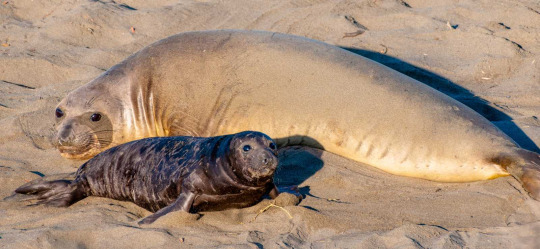
(image: a mother seal and pup)
A few pups are known as super weaners because they can grow exceptionally large during nursing. This is usually due to the pup being adopted by an additional female and therefore getting an extra dose of milk or it will steal milk from another pup. In a few cases, the mothers will just wait longer before weaning for unknown reasons. Average pups weigh between 110 and 160 kg (250 - 350 lbs) at weaning while super weaners can weigh up to 270 kg (600 lbs). They can put on so much blubber their ability to move becomes impaired. Super weaners are rarely observed again after leaving the rookery. It has been speculated that their excess blubber makes them exceptionally buoyant, reducing their ability to dive and making it harder to feed, leading to increased mortality.

(image: a chonky baby super weaner)
Both species of elephant seal were hunted to near-extinction in the 19th century as their blubber could be used to make exceptionally high-quality oil. After the hunting period ended, their numbers increased to the point both species are classified as least concern by the IUCN, though their populations have never risen to pre-hunting numbers and many areas that were historically occupied are now vacant. Genetic bottlenecks in both species has led to an increase in diseases and birth defects. El Nino is known to have a negative effect on northern seals by drastically increasing pup mortality, so this year was probably a bad one. One major limiting factor in their population growth is a lack of beaches to haul out on and many beaches they use are now protected by local laws or as UNESCO World Heritage Sites.
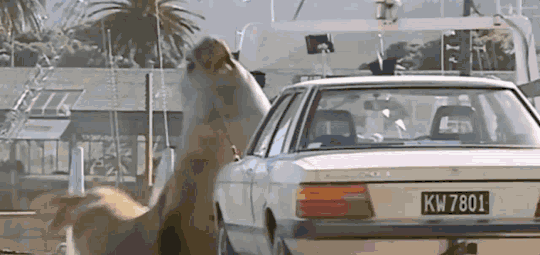
(Gif: a female versus a car. Round 1, fight!)
#wet beast wednesday#marine biology#biology#zoology#ecology#elephant seal#marine mammals#seal#seals#absolute unit#animal facts#cw animals fighting#chonky#Youtube
283 notes
·
View notes
Text
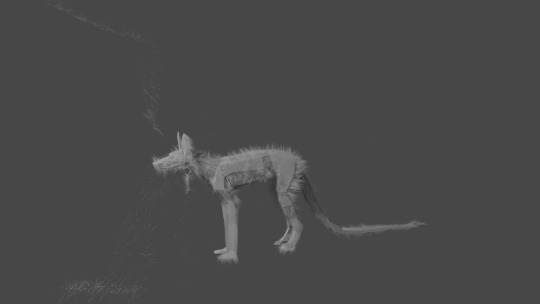

Still trying to figure out how to use Blender... at least I got the fur to stick to the body instead of exploding everywhere lol (which was the stage of my last attempt from a good whole ago). But I've still got a loooooooooooong way to go with this...
Why is there this weird bald patch on the neck?? Why does it seem to be impossible to add hair guides manually in specific places (that would make all of this SO.MUCH.EASIER)?? Why can't I seem to get the fur into better lengths/ grooms?? Why does it render some of the effing guides in the first place 😂 and not even all of them, of it does it at all?? And why is the fur so much sparser in some places despite it all being one single curve (I have a suspicion that I need to create several curves in the end)?? And how to add color to the fur (at some point)??
Will I ever find out?? 😂 Also my attempt at rigging this model was hopelessly unsuccessful, but that's a whole different rabbit hole altogether /dies
#blender#wip#3d#qualat#idk what I was thinking when I did those proportions#will have to tweak that some time#but what a mystery blender is#why does it do these weird things#it's not nearly as straightforward as I was hoping it would be XD#but hey learning is still fun#even if I HAD to jump straight into a whole ass fantasy mammal after doing the donut introduction#instead of maybe doing a couple easier steps in between to figure things out#yeah that absolutely sounds like me XD
3 notes
·
View notes
Text
I love how pandas are so entrenched into my theming and personality now that my mom stopped in the middle of her errands to buy me a panda onesie because she saw it and immediate knew I'd want one
#for the record I have previously expressed a desire for a panda themed onesie. about four years ago#but I also am known to wear onesies and have around 6 of other animals#so it's absolutely a testament to the panda thing again#also my mom came home and her first words were “Im the best mom ever”#(to which I responded “well yeah but I feel like ur saying this bc something prompted it?”)#((and. indeed getting a panda onesie after 6 years of yearning for one. we took pictures for the family gc and everything))#like we have to put it in the laundry first so it wont shed on me too much but I did wear it for like 5 seconds#and I'm still happy and hyped from those 5 seconds#and. for the record. pandas aren't even my favorite animal to any particular capacity#like I like them fine enough? but my favorite mammal is absolutely feline and my favorite animal overall is probably a bird#unfortunately can't narrow it down more specifically bc all felines are awesome (Im big on lions and caracals personally)#(but tigers and leopards and lynx and domesticated and all are also awesome!)#and. idk. all birds are great#Im usually fond of water birds (that are not waterfowl) like kingfishers#recently a bit more vibing with the local fauna tho. so rn Im in a wagtail phase#and as always corvids never miss#and also like vultures and passerines#other birds also cool but typically thats where my interests lie#sometimes also birds of prey. usually falcons but I did have an eagle phase as an 8 years old so yknow#happy posting#:D
2 notes
·
View notes
Text
I was so scared Lindsay Nikole wouldn't cover Paraceratherium, but she was saving the best for last!!!
3 notes
·
View notes